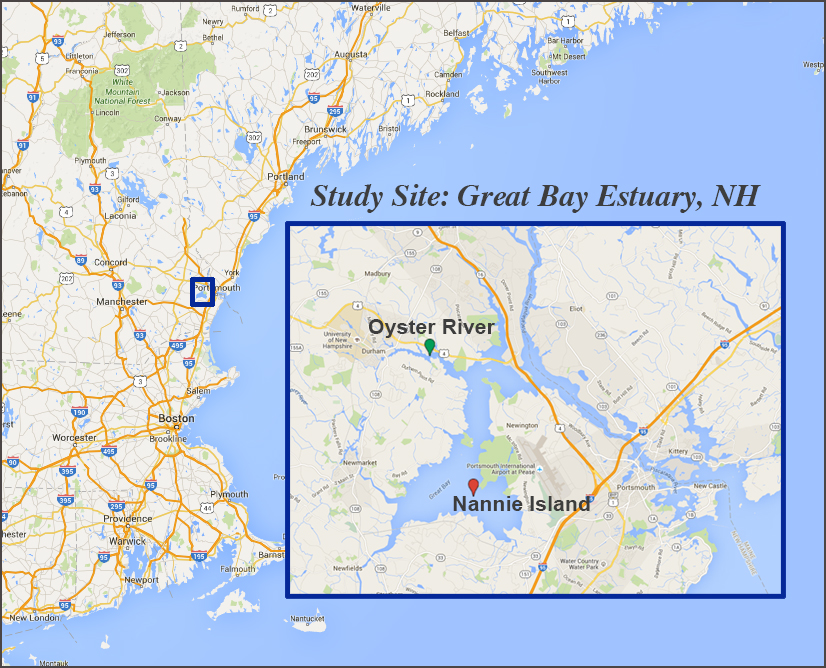 Pathogenic Vibrio species have recently emerged to be a concern to Northeast shellfish consumers. Factors affecting their incidence and concentrations in regional shellfish growing areas are not well understood, aside from seasonal water temperature. A long-term program in the Great Bay Estuary of NH has established monitoring at two sites to provide information on the monthly, bimonthly and inter-annual variability of Vibrio parahaemolyticus, Vibrio vulnificus and Vibrio cholerae, and the pathogenic strains thereof, along with an array of environmental parameters. This effort provides Vibrio strains for research and information for the NH Shellfish Program to help manage shellfish harvest practices.
Pathogenic Vibrio species have recently emerged to be a concern to Northeast shellfish consumers. Factors affecting their incidence and concentrations in regional shellfish growing areas are not well understood, aside from seasonal water temperature. A long-term program in the Great Bay Estuary of NH has established monitoring at two sites to provide information on the monthly, bimonthly and inter-annual variability of Vibrio parahaemolyticus, Vibrio vulnificus and Vibrio cholerae, and the pathogenic strains thereof, along with an array of environmental parameters. This effort provides Vibrio strains for research and information for the NH Shellfish Program to help manage shellfish harvest practices.
Vibrio parahaemolyticus is a free-living halophilic bacterium found in estuarine environments worldwide. With approximately 30,000 cases per year, V. parahaemolyticus is the most common bacterial source of seafood-borne gastrointestinal illness in the United States. Despite the cool coastal water temperatures characteristic of coastal areas in New England, Vibrio parahaemolyticus is recurrently detected in shellfish and overlying waters during warm summer months and essentially non-detectable during cold winter months, with human cases of vibriosis tracking the seasonality of V. parahaemolyticus populations in regional estuarine ecosystems.
The incidence of vibriosis in the US from V. parahaemolyticus has increased over 75% in recent years. Reports from state health departments and the Centers for Disease Control and Prevention indicate the number of reported human Vibrio infections in the New England region has dramatically increased in the past decade. Several outbreaks of V. parahaemolyticus illnesses in 2012-13 were associated with warmer than usual regional ocean temperatures and the likely regional invasion of ST36 strains. The increase in the frequency of outbreaks and reported infections has caused harvest closures and economic losses to the shellfish industry, and led most New England states to initiate V. parahaemolyticus management plans.
The relationship between total populations of V. parahaemolyticus and risk of disease to shellfish consumers remains an issue. Several reference V. parahaemolyticus concentrations imply risk thresholds: post-harvest shellfish processing approaches need to reach 30 MPN g-1 to be considered effective, and the Health Canada limit for minimal risk conditions is 100 MPN g-1. Although total V. parahaemolyticus concentrations remain the basis for management approaches to protect public health, actual risk is associated with pathogenic strains. The relationship of risk to total V. parahaemolyticus concentrations has limitations and is a key industry issue.
Shellfish aquaculturists need to know when it is safe to harvest shellfish. Ongoing UNH research provides insights into V. parahaemolyticus ecology, some models for forecasting risk conditions associated with Vibrios in shellfish, and post-harvest management practices to reduce exposure. One of the present modeling limitations is the inability to capture finer temporal scale variations in total V. parahaemolyticus concentrations and strain diversity. Further research on plankton and oyster microbiomes will provide a better understanding of how these factors impact rapid changes in V. parahaemolyticus levels. This is critical, as shellfish managers continue to deal with illness cases and outbreaks in areas that appear no different in environmental conditions and V. parahaemolyticus levels than nearby areas without illness occurrence. Recent findings by UNH researchers provide tools for detecting the most prevalent pathogenic V. parahaemolyticus strains in New England. Thus, we now can track pathogenic strains in shellfish harvest areas, understand their ecology and causes of emergence, and construct robust forecasting models that more accurately predict risk conditions. The research is supported by NSF/EPSCoR and NH Agriculture Experiment Station funding.